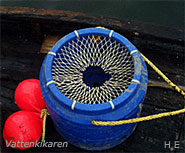
|
|
Plenty of whelks in the Kattegatt
Test fishing showed ample stocks in the
Kattegatt and that were good possibilities for a future whelk fishing industry.
The largest catches were found on soft bottoms at a depth of about 20m.
The goal of test fishing was not to catch as many as possible, but rather
to try and map populations over a large area. Weighted plastic barrels with
netted entrances on the top, so-called were used and baited with fish remains.
A total of 5,5 tons were fished with an average of 1,7kg in each trap. Every
trap attracts whelks over a radius of 20m, which is equal to an area of
1000 sq.m.
The average weight was between 40 to 85g. Smaller snails were
probably under represented as they were able to flee out of the traps and
because they are more common in shallower water. When the average size is
compared with whelks from other countries, the Swedish whelks were much
larger and this is positive for fishermen as they get paid more for larger
whelks than smaller. Whelks fetch a price of about 4SKr per kilo with their
shells and of the total weight, about 25% is edible. Water depth is of importance
for the quality of the meat, quality was lower amongst those whelks that
lived in deeper water. To maximize catches, the traps should be left in
the water for 2-3 days, a longer period does not increase catches. Those
factors that have an effect on catch size are mating season, water temperature
and water currents. "Secondary catches" in whelk traps are small
(11 %) and consist mainly of red whelks (Neptunea antiqua) and different
specie of crabs.

Whelk traps imported from England
where it is common to fish with 50 to 60 traps
linked together at a distance of 18 metres.
|

|
Page 13
of 15
|

|
|